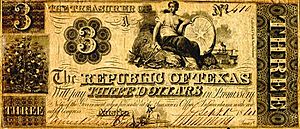Coat of arms of Texas facts for kids
| Related Usage | |
|---|---|
| Versions | |

Seal of Texas
|
|

Texas Army National Guard Crest
|
The Coat of Arms of the State of Texas is a special symbol that represents the state. It's like an official badge or emblem. Texas is one of many states in the United States that has its own unique coat of arms. The design you see today is very similar to the one used by Texas when it was its own country, called the Republic of Texas, before it joined the United States.
Contents
What the Texas Coat of Arms Looks Like
The Texas Coat of Arms shows a white star with five points. This star is placed on a blue background. Around the star, you'll see branches from an olive tree and a live oak tree. These elements are very important symbols for Texas.
History of the Texas Coat of Arms
Becoming Independent
In 1836, Texas became independent from Mexico. This meant it needed its own national symbols. A "lone star" was already a popular symbol for the independence movement. You could see it on many flags from that time.
On January 25, 1839, the leaders of the new Republic of Texas passed a law. This law officially created the republic's flag, its great seal, and its coat of arms. All of these symbols featured the lone star.
Early Designs and Interpretations
The new coat of arms for the Republic of Texas was described as "a white star of five points on an azure ground encircled by olive and live oak branches." "Azure" means blue.
However, some parts of this description were a bit unclear. For example, the "azure ground" could be seen as a traditional shield shape or a round background. Also, it wasn't clear exactly where the olive and live oak branches should be placed. They could be inside the shield with the star, or outside, supporting it.
Texas as a State
Joining the United States
In 1845, Texas joined the United States and became a state. Texas kept its national flag and seal as symbols for the new state. However, there wasn't a specific law for a state coat of arms at that time.
The main parts of the 1839 design – the five-pointed white star and the olive and live oak branches – remained important. They were still used in the state seal.
Standardizing the Design
Over the years, many different versions of the state seal appeared. Some had extra decorations or the wrong types of oak leaves. By 1991, nearly 20 different versions of the seal were being used on state papers.
To fix this, a special group called the Texas State Seal Advisory Committee was formed. Their job was to create clear rules for the state seal's design. They decided to base the design on a written description, not just an old picture.
The committee recognized that the star, olive, and live oak branches were the most important historical symbols of Texas. So, in June 1992, they officially approved the design for the Texas State Arms. This new coat of arms is essentially the same as the Republic of Texas coat of arms, but without the blue background.
How the Coat of Arms is Used
The Texas Coat of Arms is used as an official symbol of the state. It doesn't have its own separate legal power.
- You can see the Coat of Arms of the Republic of Texas on the inside and outside of the Texas State Capitol building in Austin, Texas.
- The Coat of Arms of Texas is also featured on several medals given by the Texas Army National Guard. These include the Texas Purple Heart Medal and the Texas Faithful Service Medal.
See also
- Coats of arms of the U.S. states






